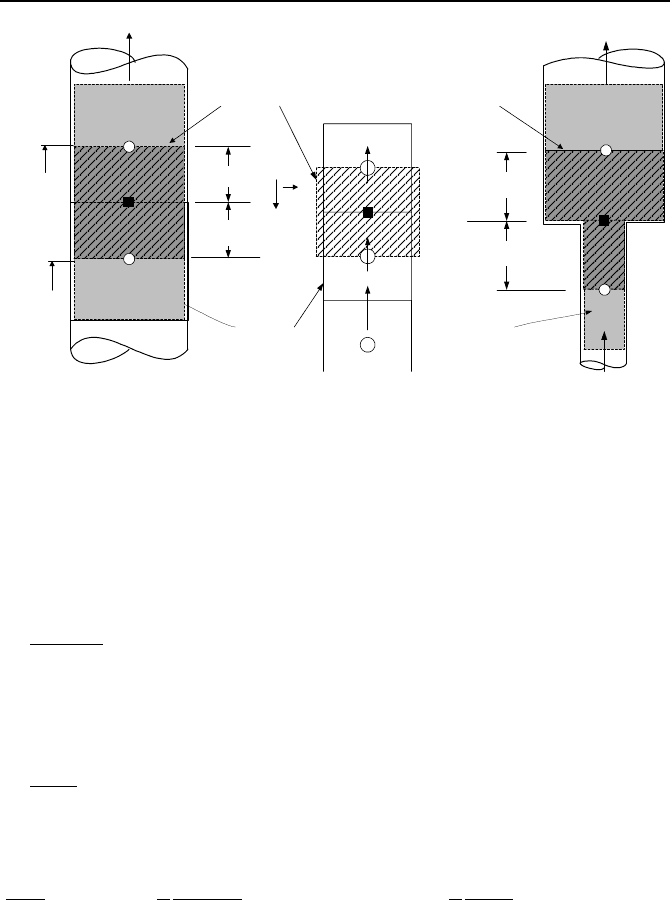Massoud M. Engineering Thermofluids: Thermodynamics, Fluid Mechanics, and Heat Transfer
Подождите немного. Документ загружается.


782 VIc. Applications: Fundamentals of Turbomachines
a) Find the flow rate, b) How do you maximize efficiency? [Ans. a) V
= 18,655,
and b) N = 1432 rpm].
14. Solve problem 3 for
∆Z = 50 ft, D = 16 in, and L = 500 ft. All other data re-
main the same. [Ans. a)
V
= 28,880, b) N = 392 rpm].
15. A pump delivering water at a rate of 100,000 GPM. The maximum available
NPSH is 50 ft. Find the maximum speed to avoid cavitation.
16. In Example VIc.5.1, we derived the efficiency of a Pelton wheel in terms of
V
w
, V
t
, and
β
. Use a deflection angle of 165
o
, H2gV
w
= , and V
t
= ωR, as
shown in Figure VIc.5.1 and show that the Pelton wheel works most effectively
when running at half the speed of the jet of water. Find the maximum efficiency.
Comment on the actual Pelton wheel efficiency.
[Ans.:
η
max
= 97%.
η
actual
<
η
max
due to the involved frictions].
17. Find the maximum power produced by a Pelton wheel. The jet diameter is
10.45 in and the available head is 2,200 ft. [Ans.: Maximum power is the power
delivered to the jet at a C
v
= 1. Hence, V
j
= 376.4, A
j
= 0.596 ft
2
,
in
W
=
56,000 hp].
18. A screw-type reciprocating compressor having helically-grooved rotors is
shown in the figure. Mention two advantages associated with this design. [Ans.:
Pulse free and compact].
19. An impulse turbine is used to produce power from an available head of 500 m
and flow rate of 100,000 GPM. Find the diameter of the jet and the maximum
power that can conceivably be produced by the turbine.
[Ans.:
H2/V gA
j
=
and
()
2/
3
max
jjj
VAW
ρ
=
].
20. An impulse turbine is operating at h = 700 m and
V
= 150,000 gpm. The
Pelton wheel has a diameter of 20 ft and rotating at 300 rpm. Find the power pro-
duced and the efficiency of the turbine. C
v
= 0.94.
[Ans.: V
j
= 385.6 ft/s, V
t
= V
j
/2.
21. An impulse turbine operating at a net head of 2000 ft uses a Pelton wheel of
diameter 12 ft and a jet flow area of 5 in. Find the turbine power corresponding to
the best efficiency. Use velocity coefficient of 0.94 and a bucket angle of 165
o
.
[Ans.: V
j
= 337 ft/s, V
t
= 169 ft/s, V
= 45.95 ft
3
/s].

Questions and Problems 783
22. Use the Bernoulli equation and show that, for a wind turbine, the wind veloc-
ity is the arithmetic average of the velocity upstream and downstream of the pro-
peller.
23. Wind is approaching a wind turbine at 27 mph, as shown in Figure VIc.5.3.
The wake wind has a velocity of 15 mph. Find a) the wind velocity at the blade
and b) the corresponding power extracted by the turbine.
24. A wind turbine has a diameter of 34 m and a power output of 350 kW at a
wind velocity of 12.5 m/s. Find the efficiency of this turbine. Assume air at 27 C.
[Ans. 33.6%].
25. A wind turbine having an efficiency of 35% and rotor diameter of 33 m is ex-
posed to air flowing at a speed of 6 m/s. Find the power developed by the turbine.
Assume
ρ
= 1.2 kg/m
3
. [Ans.: 38.8 kW].
26. A two-blade wind turbine is exposed to 60 mile/h wind. Downstream of the
propeller the wind speed is 45 mile/h. The propeller has a diameter of 45 ft. As-
sume ideal gas and standard condition for air to find a) the thrust on the wind tur-
bine, b) the power delivered to the wind turbine, c) the maximum power extracted
by the wind turbine, d) the maximum efficiency obtained from this wind turbine.
27. A two-blade wind turbine is installed on top of a hill experiencing winds of up
to 80 mile/h. Downstream of the propeller the wind speed is 50 mile/h. Assume
ideal gas and standard condition for air and find the tip to tip diameter of the pro-
peller to obtain a theoretical efficiency of 50%.

784 VId. Applications: Simulation of Thermofluid Systems
VId. Simulation of Thermofluid Systems
In this chapter we study the response of such systems as reactor coolant pump
(RCP), pressurizer, steam generator, containment, and the reactor coolant system
(RCS) of a PWR to imposed transients. We begin by introducing some pertinent
terms used in computer simulation and analysis of reactor thermal hydraulics.
1. Definition of Terms
Mathematical model refers to the application of the fundamental and constitu-
tive equations to represent a physical phenomenon.
Computational cell is a control volume for which the physical phenomena are
considered and mathematical models are developed. Since single-phase or two-
phase fluid may flow through a computational cell, we need to identify the number
of unknowns and set up a number of equations. For single-phase flow in a cell,
there are five unknowns namely, P, T, V
x
, V
y
, and V
z
. There are also five equa-
tions, conservation equation of mass, conservation equation of energy, and three
conservation equations of momentum.
For two-phase flow through the cell, there are ten unknowns namely, P, T
l
, T
v
,
(V
x
)
l
, (V
y
)
l
, (V
z
)
l
, (V
x
)
v
, (V
y
)
v
, (V
z
)
v
, and void fraction (
α
). Similarly, there are also
ten equations consisting of two conservation equations of mass, two conservation
equation of energy, and six conservation equations of momentum. Other un-
knowns are found from constitutive equations.
Node is the same as a computational cell. For the flow of water in a pipe, for
example, we may divide the length L of the pipe into N sections. Therefore, the
pipe now consists of N nodes, each having a length of l = L/N. For single-phase
flow through the node, one pressure and one temperature would represent the en-
tire node regardless of its size. Therefore, the higher the number of the nodes, the
higher the amount of information obtained for the nodalized system. Pressure is
generally calculated at the center of the node.
Node constituents in general may include several fluid fields such as continu-
ous liquid, mixture of steam and gas, liquid droplets, and ice. The number of un-
knowns and equations increases with increasing number of the cell constituents.
For example, if a cell contains liquid, steam, ice, drops, and 10 different non-
condensable gases, there are as many as fourteen conservation equations of mass.
Nodalization. To determine the state parameters in a system, such as the pri-
mary side of a PWR, the system is broken down into several nodes. The process
is generally referred to as nodalization. Figure VId.1.1 shows a section of a sys-
tem, such as a hot leg, which is divided into N nodes with 1 ≤ k ≤ N.
Control volume for mass and energy is shown in Figure VId.1.1(a). In this
figure, nodes shown by k –1, k, and k + 1 represent three sequential control vol-
umes for calculation of mass and energy.

1. Definition of Terms 785
Control volume for mass and energy
k - 1 k + 1
k
Control volume for momentum
j - 1
j
j + 1
(a) (b)
Figure VId.1.1. Nodalization of a horizontal pipe
Junctions or flow paths allow separate nodes to communicate. Hence, the
mass and energy control volumes are connected together by junctions. Fig-
ure Id.1.1(b) shows junction j connecting the mass and energy control volume k to
the mass and energy control volume k + 1.
Control volume for momentum. We may assign a control volume to node j
extending from the center of node k to the center of node k + 1. This constitutes
the control volume for the conservation of momentum for this one-dimensional
flow. Momentum properties are calculated for this control volume. The most no-
table property calculated at node j is the flow velocity. Therefore, while pressure
and temperature are calculated at the center of the mass and energy control vol-
ume, flow velocity is calculated at the junction.
Donor cell can be explained by considering two computational cells exchang-
ing mass, momentum, and energy. The convective properties entering the receiv-
ing cell from the upstream cell are those of the upstream or so called donor cell.
In Figure VId.1.1 for example, the enthalpy entering node k from node k – 1 is the
enthalpy of node k – 1. Since there is no gradient inside a node, the enthalpy at
the junction between nodes k – 1 and k is the same as enthalpy at the center of
node k – 1.
Field, component, and phase. In Chapter IIIa and IIIb we dealt with homoge-
nous fields (all water, all air, etc.) In general, fields may also be heterogeneous
(Chapter IIIc). Consider for example, a vapor consisted of steam and several non-
condensable gases. Each of the constituents is referred to as a component of the
field. Phase, on the other hand, is the various forms of the same substance such as
ice, water, steam, mist, and drop.
Two-flow field model (two-fluid model) refers to the treatment of the flow
fields in a computational cell. Assuming only water and steam exist in the cell,
ten conservation equations are used in the two-fluid model to describe the condi-
tions in the cell. Thus, in this mathematical model, water and steam can be at dif-
ferent temperatures flowing at different velocities.
HEM or the homogenous equilibrium model, refers to the treatment of the fluid
in a computational cell. Assuming only water and steam exist in the cell, the two
phases are assumed to be at thermodynamic equilibrium. Thus, both phases flow
at the same velocity in the same direction having the same temperature.
SEM or the separated equilibrium model refers to a deviation from the HEM,
by the introduction of the slip ratio. This in turn requires the inclusion of the in-

786 VId. Applications: Simulation of Thermofluid Systems
Figure VId.2.1. Nodal diagram of a two-loop PWR primary side
ter-phase friction force in the momentum equation. In both HEM and SEM the
mixture properties such as
ρ
and u are obtained through the use of void fraction.
2. Mathematical Model for a PWR Loop
Determination of such parameters as pressure, temperature, and velocity in sys-
tems involving fluid flow and heat transfer is generally an involved task. A nu-
clear reactor is an example of a thermofluid system for which it is important to de-
termine such parameters by mathematical modeling. For this reason many
computer codes are developed to study various operational aspects of a nuclear
power plant. For example, several codes are devised to evaluate the thermal hy-
draulic characteristics of only the reactor core. Among the computer codes devel-
oped to analyze the reactor coolant system are RELAP, RETRAN, and TRAC. In
this section, we study the mathematical model based on the HEM for analysis of
the reactor coolant system. A nodalization example of a two-loop PWR is show in
Figure VId.2.1.
Control volumes for mass and energy (shown with subscripts k and k + 1) and
for momentum (shown with subscript j) are shown in Figure VId.2.2 for constant
and variable area channels. The conservation equations of mass, momentum, and

2. Mathematical Model for a PWR Loop 787
Momentum
Control
Volume
Mass & Energy
Control Volume
k+1
Z
k+1
Z
k
g
i
Z
k+1
Z
k
Momentum
Control
Volume
Mass & Energy
Control Volume
k
k+1
k
(a)(b)
(c)
k + 1
j
k
j
j
k+1
L
k+1
/ 2
L
k
/ 2
L
k+1
/ 2
L
k
/ 2
k - 1
Figure VId.2.2. Mass, ener
gy
, and momentum control volume for channels with fixed o
r
variable flow area
energy are described here. The area change plays no role for the conservation of
mass and energy equations but the conservation equation of momentum, which is
more involved, must consider the variable area channel. For node k, the conserva-
tion equation of mass, Equation IIa.5.1 can be written as:
()
() ()
¦¦
−=
exitinlet
m
VAVA
dt
d
ρρ
ρ
V
VId.2.1
where
ρ
m
= (1 –
α
)
ρ
f
+
αρ
g
and
α
is given by Equation Va.1.3. We may also write
Equation VId.2.1 as:
dt
dM
k
=
jj
mm
−
−1
VId.2.1-1
The conservation equation of energy as given by Equation IIa.6.4 becomes:
() ()
kjk
jj
j
jjkj
jj
j
jj
k
Qzzg
A
m
hmzzg
A
m
hm
dt
dU
+
»
»
¼
º
«
«
¬
ª
−++−
»
»
¼
º
«
«
¬
ª
−++=
−
−−
−
−−
22
2
1
2
1
2
1
2
1
11
2
1
2
1
ρρ
VId.2.2
where in Equation VId.2.2, we ignored the rate of change in the kinetic energy as
compared with the internal energy. Equation VId.2.2 includes enthalpy terms de-
veloped at the junctions. For fine nodalization, with good degree of approxima-
tion, we may use h
j – 1
= h
k – 1
and h
j
= h
k
. This is consistent with the donor cell ap-

788 VId. Applications: Simulation of Thermofluid Systems
proach. However, there are certain nodes that require special treatment such as
heated nodes within which density and enthalpy change substantially.
The one-dimensional momentum equation for the mixture can be readily ob-
tained by applying Equation IIIa.3.44 to the variable channel area of Fig-
ure VId.2.2. The momentum control volume is centered at j and it extends from
L
k
/2 and L
k + 1
/2. Substituting for various pressure drop terms, for the lower seg-
ment we get:
2
2
/2
22
[( ) ( )
2
jj
kkk
j
k
kk
kk kk
dm m
LmM
P
Pg
Adt A
AA
ρρ
=− − + − + +
22
K]
2
22
jj
kk
k
j
k
k
jj
kk
mm
mm
L
f
D
AA
φφ
ρρ
+
where
φ
is the two-phase friction multiplier, as defined in Chapter VI. Now, we
apply Equation IIIa.3.44 to the portion of the momentum control volume extend-
ing from j, right after the change in flow area to point k + 1:
2
2
(1)/2
11
1
22
11
11 11
[( ) ( )
2
jjk
kk
j
k
kk
kk kk
M
dm m
Lm
PP
Adt A
AA
ρρ
+
++
+
++
++ ++
=− − + − + +
11
1
1
22
1
11
K]
2
22
jj
kk
k
j
k
k
jj
kk
mm
mm
L
f
D
AA
φ
ρρ
++
+
+
+
++
+
Adding these equations, the result for the one dimensional momentum equation
for variable area channel becomes:
1
1
2
22
1
1
2222
11 1
(1)/2
11
/2 1
1
222
11
11
22
11
[( ) ( ) ( )
2
()( K]
22
222
j
kk
kk
j
kk
pump
kk
j
kk kk k k
jj
k
kk k k
kk k
j
kk
jjkk k k
kk k k
dm
LL
AAdt
m
mm
PPP
AAAA
mm
Mmmmm
ML L
gf f
AA D D
AAA
ρ
ρρ
φ
ρρρ
+
+
+
+
++ +
+
++
+
+
++
++
ªº
«»
«»
¬¼
+=
∆− −+ − − −
−+ + +
VId.2.3
Example VId.2.1. Start with Newton’s second law and derive Equation VId.2.3.
Solution: The momentum equation expresses that the net momentum flux to or
from a control volume plus the rate of change of momentum in the control volume
is equal to the net external forces acting on the control volume. We now apply
this principle to a differential control volume located between z and z + dz. This
control volume has a flow area of A and a hydraulic diameter of D
e
. External

2. Mathematical Model for a PWR Loop 789
forces are the body force and the surface forces. Hence, the net force acting on the
control volume becomes:
()()(K)
2
zzdz
e
mm
dz
dF A P P s Adz g f
D
A
ρφ
ρ
+
¦
=−− − +
where s is introduced to account for the flow direction. For upward flow s = +1,
for horizontal flow, s = 0, and for downward flow s = –1. The absolute value for
flow rate signifies the fact that the friction force acts always opposite to the flow
direction. Hence using the convention of 0>m
for up-flow, the friction force
becomes negative i.e., kFF
K
K
−= . Similarly for down-flow ( 0<m
), the friction
force would act in the direction of the z-axis, kFF
K
K
= . Accounting for the rate
of change in momentum flux, the rate of change of momentum of the control vol-
ume is therefore given by:
22
()()(K)[()()]
2
z
zdz zdz z
e
mm
mdzmm
dz A P P s Adz g f
tDAAA
ρφ
ρρ ρ
+ +
∂
=−− − + − −
∂
We now divide both sides of this equation by Adz and let dz approach zero:
z
Am
A
A
mm
D
fgs
z
P
t
m
A
e
∂
∂
−−−
∂
∂
−=
∂
∂ )/(1
2
11
2
2
ρ
ρ
φρ
We may apply this equation to the control volume of Figure VId.2.2(c), which is
located between elevations Z
k
and Z
k+1
. To obtain the momentum equation for this
control volume, we multiply both sides of this equation by dz and integrate the re-
sulting equation first over the portion of the momentum control volume extending
from k to j right before the flow area changes. Integration over the lower portion
of the control volume yields:
()
³
µ
¶
´
¸
¸
¹
·
¨
¨
©
§
−
µ
¶
´
−−−−=
µ
¶
´
j
k
j
k
f
e
j
k
ki
j
k
A
m
d
A
dz
A
m
D
f
gdzsPPdz
dt
md
A
v1
v
2
)(
1
2
2
2
φ
ρ
Term by term integration is carried out as follows:
dt
md
A
L
dz
dt
md
A
j
k
k
j
k
2
1
≈
µ
¶
´
k
k
j
k
k
A
gsMgsL
gdzs
2v2
=
µ
¶
´
=
ρ
dz
A
m
D
f
f
j
ke
2
2
v
2
µ
¶
´
φ
2
,
v)K
2
(
2
1
k
jj
f
k
ke
k
A
mm
D
L
f
¦
+=
φ

790 VId. Applications: Simulation of Thermofluid Systems
¸
¹
·
¨
©
§
µ
¶
´
A
m
d
A
j
k
v1
2
2
2
2
v
v
k
kk
k
jj
A
m
A
m
−=
Adding up terms we get:
)
v
v
(
2
v)K
2
(
v2
)(
2
2
2
2
2
2
,
k
kk
k
jj
k
kk
kk
ke
k
k
k
k
kj
i
k
k
A
m
A
m
A
mm
D
L
f
gsL
PP
dt
md
A
L
−−
¦
+−−−−=
We now apply the resulting equation to the portion of the momentum control vol-
ume extending from j, right after the change in flow area, to point k+1, yielding:
11
111
1111
2
11,11
2
2
11
22
11
() ( K)v
22v22
v
v
()
kk
ki k k
kj k kk
kkekk
jj
kk
kk
mm
Ldm sLg L
PP f
Adt D A
m
m
AA
++
+++
++++
++++
++
++
¦
=− − − − +
−−
Adding these equations, to get the one dimensional momentum equation for vari-
able area channels:
)]
2
vK
2
v
2
2
v
2
(
2
v
)
11
()
vv
(
v2
)(
)[(
22
22
1
11
,
1,
1
1
2
,
,
2
22
1
2
2
2
1
1
2
1
1
1,
1
1
j
jj
ii
k
kk
if
ke
k
k
k
kk
if
ke
k
k
jj
kkk
kk
k
kk
i
kki
kkkpump
j
k
k
k
k
A
mm
A
mm
D
L
f
A
mm
D
L
f
m
AAA
m
A
m
gLLs
PPP
dt
md
A
L
A
L
¦
+++
−−−
+
+
+−−∆=
»
¼
º
«
¬
ª
+
+
++
+
+
+
++
++
+
+
+
+
φ
This equation includes a pressure rise term in case there is a pump in the flow
path. This equation while derived for single-phase flow is applied to two-phase
mixture with the introduction of the multiplier
φ
and v .
Equations VId.2.1, VId.2.2, and VId.2.3 constitute a set of differential equa-
tions in mass, internal energy, and mass flow rate. Writing similar sets for the rest
of the nodes would result in a system of differential equations, which upon solu-
tion would result in obtaining the key parameters versus time. The initial condi-
tions are found from the steady state operation prior to the imposition of a tran-
sient.

3. Simplified PWR Model 791
k
¦
x
m
B
m
¦
i
m
¦
e
m
k
()
¦
xx
hm
kB
hm
()
¦
ii
hm
()
¦
ke
hm
Q
(a) (b)
Downcomer
Downcomer
core core
Lower plenum
(c)
Figure VId.3.1. (a) mass and (b) energy transfer for a typical node. (c) Exam
p
le of
a
multi-port node
3. Simplified PWR Model
The level of information obtained from a mathematical model depends on the ex-
tent of complexities used in the model such as the multi-dimensional analysis of
multi-component flow. We may introduce a variety of simplifying assumptions to
reduce the computational burden and obtain results with reasonable accuracy.
However, simplifying assumptions impose limitations on the applicability of the
model. An example of a simplifying assumption is the application of an integral
or loop-wide momentum equation. This assumption decouples the solution of the
momentum equation from the mass and energy equations. To see the saving in the
number of equations, consider a case where there are N nodes in each loop of Fig-
ure VId.2.1. According to the model developed in Section 2, there are a total of
6N equations for the N nodes. By writing an integral momentum equation for
each loop, the number of equations drops to 2N + N’ where N’ is the number of
loops. An integral momentum equation ignores the compressibility of fluid due to
the local pressure changes and assumes that the pressure and velocity disturbances
are propagated at infinite velocity. This allows us to assign one pressure to the en-
tire RCS and one loop flow rate to each loop.
Let’s now obtain the set of equations for node k (Figure VId.3.1) using the
above simplifying assumption. For this purpose, we consider the various interac-
tions with node k. Flow may enter this node from several inlet ports (shown with
subscript i) and leaves from several exit ports (shown with subscript e). These are
